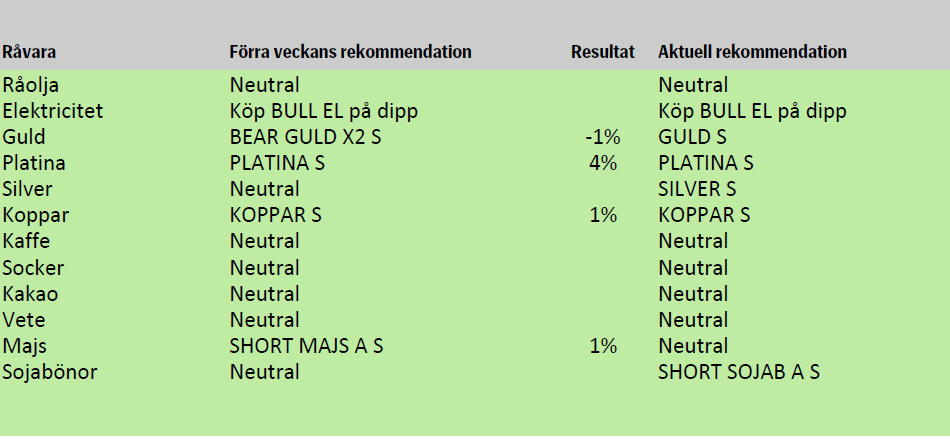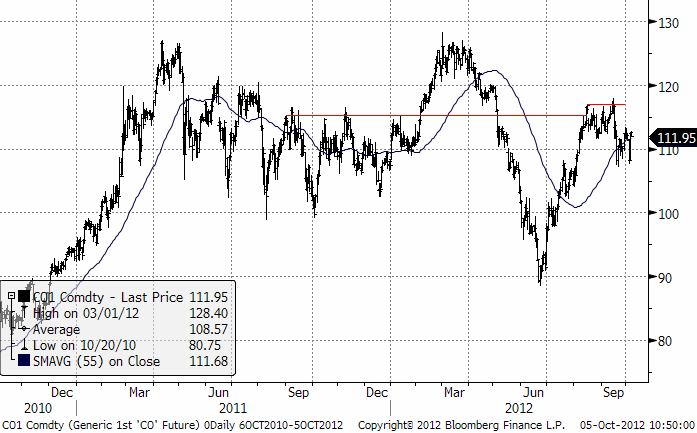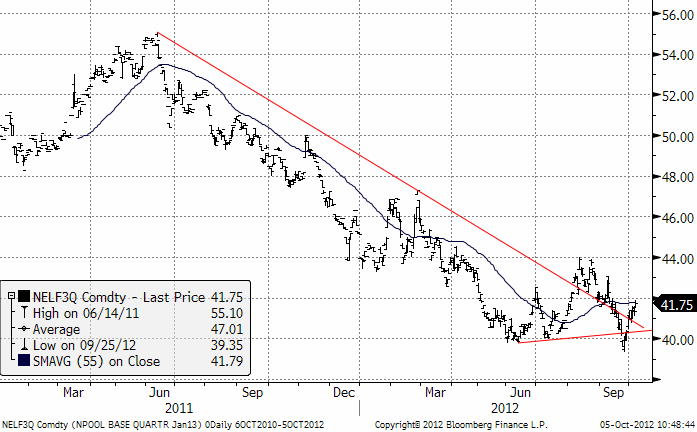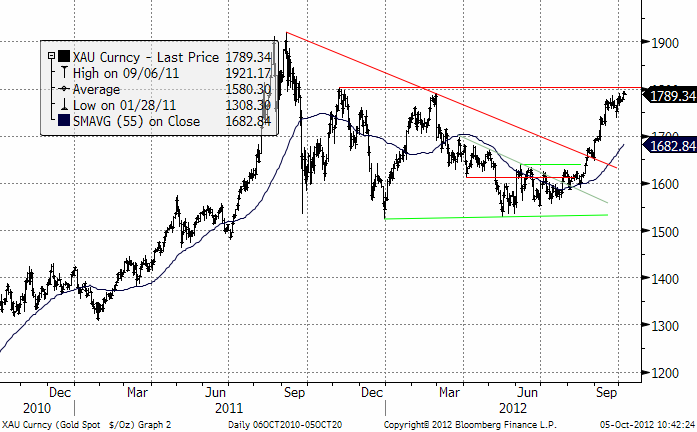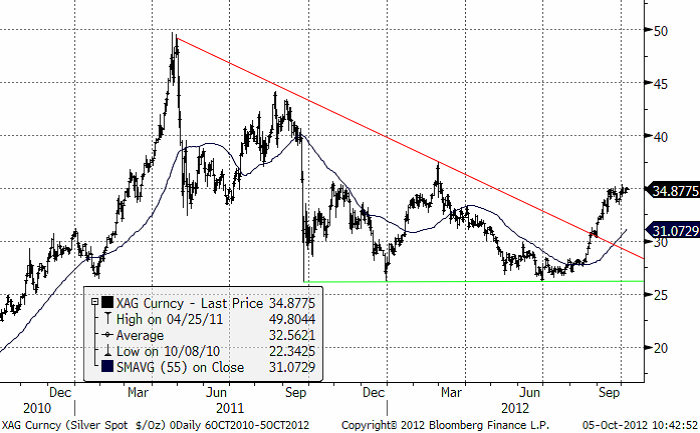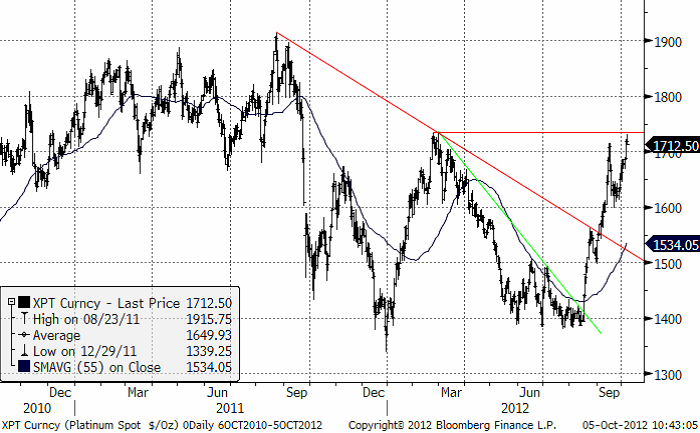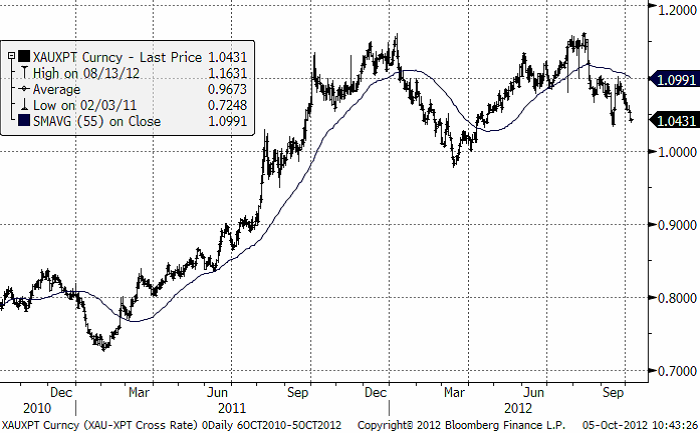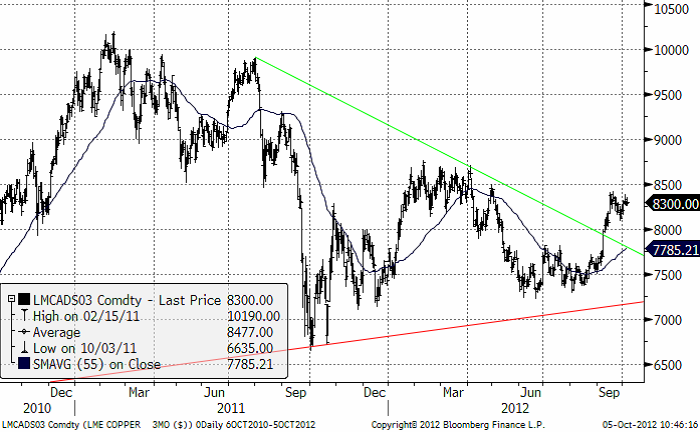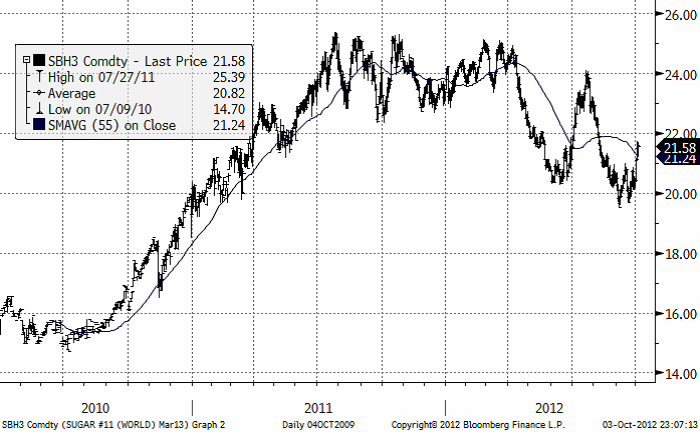Analys
SEB – Råvarukommentarer, 5 oktober 2012
Sammanfattning av rekommendationer
Förra veckans rekommendationer gav en samlad vinst på 5%. Vi stänger den korta positionen i majs. Vi väljer att gå kort. Sojabönor, som dock ligger på tekniskt stöd nu och som man hellre bör sälja på rekyler uppåt. Vi stänger förra veckans mycket kortsiktiga kontra-trend-rekommendationen i guld, som visade sig vara fel. Platina fortsätter att vara vår huvudfavorit.
Råolja – Brent
Råoljemarknaden har var under press i veckan och Brent var på onsdagen ned hela 3%. Flera olika faktorer har bidragit till pressen ned. Marknaden har tidigare varit mer fokuserad på störningar på utbudssidan och på den geopolitiska oron i Mellanöstern. Tecken på vikande aktivitet i Kina har, tidigare, inte påverkat priset på olja på samma sätt som t e x metaller. Nu verkar det ändå skett ett skifte där man prisar in efterfrågefaktorer mer. Tecken finns bland annat på att sanktionerna mot Iran börjar ge resultat (se nedan). Dessutom redovisas högre produktion från bland annat Ryssland, Irak och också från USA, som nu är uppe på den högsta produktionsnivån sedan 1996! med 6.52 miljoner fat/dag.
Flera faktorer på utbudssidan har mildrats; Det verkar som sanktionerna mot Iran börjar ge resultat. Regimen pressas sedan tidigare av uteblivna intäkter från oljeexport. I september exporterades 1.15 miljoner fat/dag jämfört med 2.4 miljoner fat/dag i genomsnitt förra året. Nu har dessutom uppvärmningssäsongen inletts. Iran har, trots att man är stor nettoexportör av råolja, inte tillräcklig raffinaderikapacitet för att förse den inhemska marknaden med oljeprodukter som bensin, diesel och olja för uppvärmning. Istället måste man köpa dessa produkter på den internationella marknaden – till höga priser (bland annat p g a sanktionerna). Att den egna valutan dessutom urholkats i värde gör inte saken bättre. Höga matpriser har redan drivit upp inflationen och nu är situationen än värre. Trycket på regimen är så stort, att chansen för att man återgår till förhandlingar med USA och EU, är bättre än på länge.
I september var rekordstor kapacitet i Nordsjön borta från marknaden p g a underhåll och reparationer. Många av dessa arbeten är försenade men vi räknar ändå med att utbudet snart ökar, vilket bör mildra pressen uppåt på olja. Vi har också passerat den säsongsmässiga toppen på orkansäsongen utan några allvarliga implikationer på oljemarknaden (med undantag för Isaac som kortsiktigt störde produktion och distribution i mexikanska gulfen).
Trots ovanstående argument för nedsidan, så ser vi värde kring Brentpris kring nivåer där priset tidigare vänt åter upp (kring 107-108 usd). Detta då den geopolitiska situationen i Iran och Syrien m fl länder fortsatt verkar för en premie på oljepriset. I skrivande stund handlas kontraktet på 110.20, där vår rekommendation, förblir neutral.
Elektricitet
Elterminerna har rört sig sidledes till svagt upp sedan förra veckan.
I det mesta är situationen oförändrad. Den hydrologiska balansen visar fortsatt på överskott på ca 12-15 TWh och väderprognoserna indikerar mer än normal nederbörd de närmaste 10 dygnen, medan temperaturen indikerar kring normal. Vi är inne i en årstid där normaltemperaturen är fallande men än så länge är det nästan uteslutande regn som fallit.
Vattenmagasinen är mycket välfyllda och kärnkraften har god tillgänglighet med 84% av kapaciteten igång, vilket innebär fortsatt risk för ”körpress” för vattenkraftproducenterna.
Trots det har man lyckat få lite andrum, spotpriset har stigit och spreaden mellan södra Norge och systempris har minskat. Orsaken är bättre kapacitet på kablar för export från Norge samt den säsongsmässiga temperaturminskningen. Vi håller fortsatt en neutral rekommendation men gör oss beredda att köpa.
Guld och silver
Den tekniskt kritiska nivån på nedsidan som vi skrev om förra veckan ($1748) bröts aldrig. Det är först om priset på stängningsbasis ligger under som vi tror att en större rekyl är förestående (som skulle kunna innebära en kortsiktig affärsmöjlighet med en kort position). Som det ser ut just nu strävar istället priset uppåt, och ligger strax ovanför den övre delen av de senaste veckornas konsolideringsintervall, i skrivandes stund handlas $1791. Ligger marknaden kvar på nuvarande nivå eller högre på måndag, så är det en starkare signal eftersom brottet är i riktning med trenden. För den som inte redan köpt, kan det snart vara dags. Timingen är viktig, och den tekniska analysen kan därför vara en värdefull vägledning.
Nedan ser vi kursdiagrammet för guld i dollar per troy ounce.
Nedan ser vi kursdiagrammet för silver i dollar per troy ounce.
Platina
Platina är vinnaren, upp 3,5 % sedan förra fredagen. Som befarat har strejkerna spridits i Sydafrika, nu även till guld- och järnmalmsgruvor. Anglos fyra platinagruvor utanför Rustenburg har drabbats av vilda strejker, och företaget rekommenderar de kvarvarande 20 % av arbetsstyrkan att lämna arbetet då inte säkerheten kan garanteras.
Vi tror på ädelmetaller som placering i nuvarande makromiljö. Den oroliga utvecklingen i Sydafrika har redan påverkat utbudet märkbart. Vi tror att platina priset kommer att utmana igen och återgå till ”normaltillståndet”, d.v.s. att vara dyrare än guld. I skrivandes stund har priset brutit över den tidigare toppen för några veckor sedan på $1715. Nästa tekniska motstånd kommer in vid $1735-nivån. Det ser starkt ut. Trots veckans redan positiva utveckling tror vi inte att det är för sent att köpa.
Nedan ser vi priset på guld dividerat med priset på platina. Vi väntar oss att platina ska fortsätta vinna på guldet.
Koppar
Allmänt om basmetallerna: Månadsskifte innebär inköpschefsindex (ISM), som normalt presenteras den 1:a i månaden för både Europa, USA och Kina. Metallerna korrelerar traditionellt med denna statistik. En siffra över 50 betyder tillväxt och vice versa. Kinas kom in under 50 för andra månaden i rad, men steg från augustis 49,2 till 49,8. USA överraskade med en uppgång från 49,6 till 51,5. Konjunkturen balanserar mellan tillväxt och avmattning. Kina gör vad de kan för att stimulera. Förra veckan gjordes en rekordstor påspädning av likviditet via marknadsoperationer (delvis inför den kinesiska långhelgen i samband med nationaldagsfirandet). Metallpriserna började det nya kvartalet på den positiva sidan.
Koppar och nickel är upp ca 1 % sedan förra fredagen.
Koppar
Vi har i de senaste breven beskrivit kopparmarknaden som i grunden fundamentalt stark. Stimulansåtgärderna borgar för en fortsatt stabil marknad. Det behövs fler indikationer på ökad industriell efterfrågan innan marknaden tar nya tag på uppsidan.
Priset på LME har gjort vissa försök i veckan med en högsta notering på $8380 ( $3,80/Lbs). Men återigen finns inte riktigt kraften. De finansiella aktörerna har redan positionerat sig för uppgång. För nya lyft behöver de fylla på, alternativt att industrin börjar ta en mer framsynt vy och täcker in framtida konsumtion. Kanske avvaktas LME-veckan, då världens metallfolk traditionsenligt samlas i London, i mitten av oktober. Nedan ser vi ett diagram över priset på tremånadersterminen på LME.
Vi väljer att på kort sikt rekommendera en lång position i koppar.
Kaffe
Kaffepriset har fallit tillbaka ner i konsoliderings-zonen. Vi fortsätter att vara neutrala till något positiva till kaffepriset.
Socker
Nedan ser vi priset för leverans i mars nästa år. Trots ett starkt stöd vid 20 cent, ser vi tydligt att den långsiktiga trenden är nedåtriktad.
Kakao
Kakaopriset har nått ett tekniskt stöd. Om priset stabiliserar sig vid 2400 dollar, och ser ut att ha fått fast mark under fötterna, kan det vara intressant att köpa lite försiktigt.
Vi väljer att vara neutrala i kakao till nästa vecka.
För spannmål och övriga jordbruksprodukter hänvisas till gårdagens nyhetsbrev om jordruksprodukter.
[box]SEB Veckobrev Veckans råvarukommentar är producerat av SEB Merchant Banking och publiceras i samarbete och med tillstånd på Råvarumarknaden.se[/box]
Disclaimer
The information in this document has been compiled by SEB Merchant Banking, a division within Skandinaviska Enskilda Banken AB (publ) (“SEB”).
Opinions contained in this report represent the bank’s present opinion only and are subject to change without notice. All information contained in this report has been compiled in good faith from sources believed to be reliable. However, no representation or warranty, expressed or implied, is made with respect to the completeness or accuracy of its contents and the information is not to be relied upon as authoritative. Anyone considering taking actions based upon the content of this document is urged to base his or her investment decisions upon such investigations as he or she deems necessary. This document is being provided as information only, and no specific actions are being solicited as a result of it; to the extent permitted by law, no liability whatsoever is accepted for any direct or consequential loss arising from use of this document or its contents.
About SEB
SEB is a public company incorporated in Stockholm, Sweden, with limited liability. It is a participant at major Nordic and other European Regulated Markets and Multilateral Trading Facilities (as well as some non-European equivalent markets) for trading in financial instruments, such as markets operated by NASDAQ OMX, NYSE Euronext, London Stock Exchange, Deutsche Börse, Swiss Exchanges, Turquoise and Chi-X. SEB is authorized and regulated by Finansinspektionen in Sweden; it is authorized and subject to limited regulation by the Financial Services Authority for the conduct of designated investment business in the UK, and is subject to the provisions of relevant regulators in all other jurisdictions where SEB conducts operations. SEB Merchant Banking. All rights reserved.
Analys
Brent crude ticks higher on tension, but market structure stays soft

Brent crude has climbed roughly USD 1.5-2 per barrel since Friday, yet falling USD 0.3 per barrel this mornig and currently trading near USD 67.25/bbl after yesterday’s climb. While the rally reflects short-term geopolitical tension, price action has been choppy, and crude remains locked in a broader range – caught between supply-side pressure and spot resilience.

Prices have been supported by renewed Ukrainian drone strikes targeting Russian infrastructure. Over the weekend, falling debris triggered a fire at the 20mtpa Kirishi refinery, following last week’s attack on the key Primorsk terminal.
Argus estimates that these attacks have halted ish 300 kbl/d of Russian refining capacity in August and September. While the market impact is limited for now, the action signals Kyiv’s growing willingness to disrupt oil flows – supporting a soft geopolitical floor under prices.
The political environment is shifting: the EU is reportedly considering sanctions on Indian and Chinese firms facilitating Russian crude flows, while the U.S. has so far held back – despite Bessent warning that any action from Washington depends on broader European participation. Senator Graham has also publicly criticized NATO members like Slovakia and Hungary for continuing Russian oil imports.
It’s worth noting that China and India remain the two largest buyers of Russian barrels since the invasion of Ukraine. While New Delhi has been hit with 50% secondary tariffs, Beijing has been spared so far.
Still, the broader supply/demand balance leans bearish. Futures markets reflect this: Brent’s prompt spread (gauge of near-term tightness) has narrowed to the current USD 0.42/bl, down from USD 0.96/bl two months ago, pointing to weakening backwardation.
This aligns with expectations for a record surplus in 2026, largely driven by the faster-than-anticipated return of OPEC+ barrels to market. OPEC+ is gathering in Vienna this week to begin revising member production capacity estimates – setting the stage for new output baselines from 2027. The group aims to agree on how to define “maximum sustainable capacity,” with a proposal expected by year-end.
While the IEA pegs OPEC+ capacity at 47.9 million barrels per day, actual output in August was only 42.4 million barrels per day. Disagreements over data and quota fairness (especially from Iraq and Nigeria) have already delayed this process. Angola even quit the group last year after being assigned a lower target than expected. It also remains unclear whether Russia and Iraq can regain earlier output levels due to infrastructure constraints.
Also, macro remains another key driver this week. A 25bp Fed rate cut is widely expected tomorrow (Wednesday), and commodities in general could benefit a potential cut.
Summing up: Brent crude continues to drift sideways, finding near-term support from geopolitics and refining strength. But with surplus building and market structure softening, the upside may remain capped.
Analys
Volatile but going nowhere. Brent crude circles USD 66 as market weighs surplus vs risk

Brent crude is essentially flat on the week, but after a volatile ride. Prices started Monday near USD 65.5/bl, climbed steadily to a mid-week high of USD 67.8/bl on Wednesday evening, before falling sharply – losing about USD 2/bl during Thursday’s session.

Brent is currently trading around USD 65.8/bl, right back where it began. The volatility reflects the market’s ongoing struggle to balance growing surplus risks against persistent geopolitical uncertainty and resilient refined product margins. Thursday’s slide snapped a three-day rally and came largely in response to a string of bearish signals, most notably from the IEA’s updated short-term outlook.
The IEA now projects record global oversupply in 2026, reinforcing concerns flagged earlier by the U.S. EIA, which already sees inventories building this quarter. The forecast comes just days after OPEC+ confirmed it will continue returning idle barrels to the market in October – albeit at a slower pace of +137,000 bl/d. While modest, the move underscores a steady push to reclaim market share and adds to supply-side pressure into year-end.
Thursday’s price drop also followed geopolitical incidences: Israeli airstrikes reportedly targeted Hamas leadership in Doha, while Russian drones crossed into Polish airspace – events that initially sent crude higher as traders covered short positions.
Yet, sentiment remains broadly cautious. Strong refining margins and low inventories at key pricing hubs like Europe continue to support the downside. Chinese stockpiling of discounted Russian barrels and tightness in refined product markets – especially diesel – are also lending support.
On the demand side, the IEA revised up its 2025 global demand growth forecast by 60,000 bl/d to 740,000 bl/d YoY, while leaving 2026 unchanged at 698,000 bl/d. Interestingly, the agency also signaled that its next long-term report could show global oil demand rising through 2050.
Meanwhile, OPEC offered a contrasting view in its latest Monthly Oil Market Report, maintaining expectations for a supply deficit both this year and next, even as its members raise output. The group kept its demand growth estimates for 2025 and 2026 unchanged at 1.29 million bl/d and 1.38 million bl/d, respectively.
We continue to watch whether the bearish supply outlook will outweigh geopolitical risk, and if Brent can continue to find support above USD 65/bl – a level increasingly seen as a soft floor for OPEC+ policy.
Analys
Waiting for the surplus while we worry about Israel and Qatar

Brent crude makes some gains as Israel’s attack on Hamas in Qatar rattles markets. Brent crude spiked to a high of USD 67.38/b yesterday as Israel made a strike on Hamas in Qatar. But it wasn’t able to hold on to that level and only closed up 0.6% in the end at USD 66.39/b. This morning it is starting on the up with a gain of 0.9% at USD 67/b. Still rattled by Israel’s attack on Hamas in Qatar yesterday. Brent is getting some help on the margin this morning with Asian equities higher and copper gaining half a percent. But the dark cloud of surplus ahead is nonetheless hanging over the market with Brent trading two dollar lower than last Tuesday.

Geopolitical risk premiums in oil rarely lasts long unless actual supply disruption kicks in. While Israel’s attack on Hamas in Qatar is shocking, the geopolitical risk lifting crude oil yesterday and this morning is unlikely to last very long as such geopolitical risk premiums usually do not last long unless real disruption kicks in.
US API data yesterday indicated a US crude and product stock build last week of 3.1 mb. The US API last evening released partial US oil inventory data indicating that US crude stocks rose 1.3 mb and middle distillates rose 1.5 mb while gasoline rose 0.3 mb. In total a bit more than 3 mb increase. US crude and product stocks usually rise around 1 mb per week this time of year. So US commercial crude and product stock rose 2 mb over the past week adjusted for the seasonal norm. Official and complete data are due today at 16:30.
A 2 mb/week seasonally adj. US stock build implies a 1 – 1.4 mb/d global surplus if it is persistent. Assume that if the global oil market is running a surplus then some 20% to 30% of that surplus ends up in US commercial inventories. A 2 mb seasonally adjusted inventory build equals 286 kb/d. Divide by 0.2 to 0.3 and we get an implied global surplus of 950 kb/d to 1430 kb/d. A 2 mb/week seasonally adjusted build in US oil inventories is close to noise unless it is a persistent pattern every week.
US IEA STEO oil report: Robust surplus ahead and Brent averaging USD 51/b in 2026. The US EIA yesterday released its monthly STEO oil report. It projected a large and persistent surplus ahead. It estimates a global surplus of 2.2 m/d from September to December this year. A 2.4 mb/d surplus in Q1-26 and an average surplus for 2026 of 1.6 mb/d resulting in an average Brent crude oil price of USD 51/b next year. And that includes an assumption where OPEC crude oil production only averages 27.8 mb/d in 2026 versus 27.0 mb/d in 2024 and 28.6 mb/d in August.
Brent will feel the bear-pressure once US/OECD stocks starts visible build. In the meanwhile the oil market sits waiting for this projected surplus to materialize in US and OECD inventories. Once they visibly starts to build on a consistent basis, then Brent crude will likely quickly lose altitude. And unless some unforeseen supply disruption kicks in, it is bound to happen.
US IEA STEO September report. In total not much different than it was in January
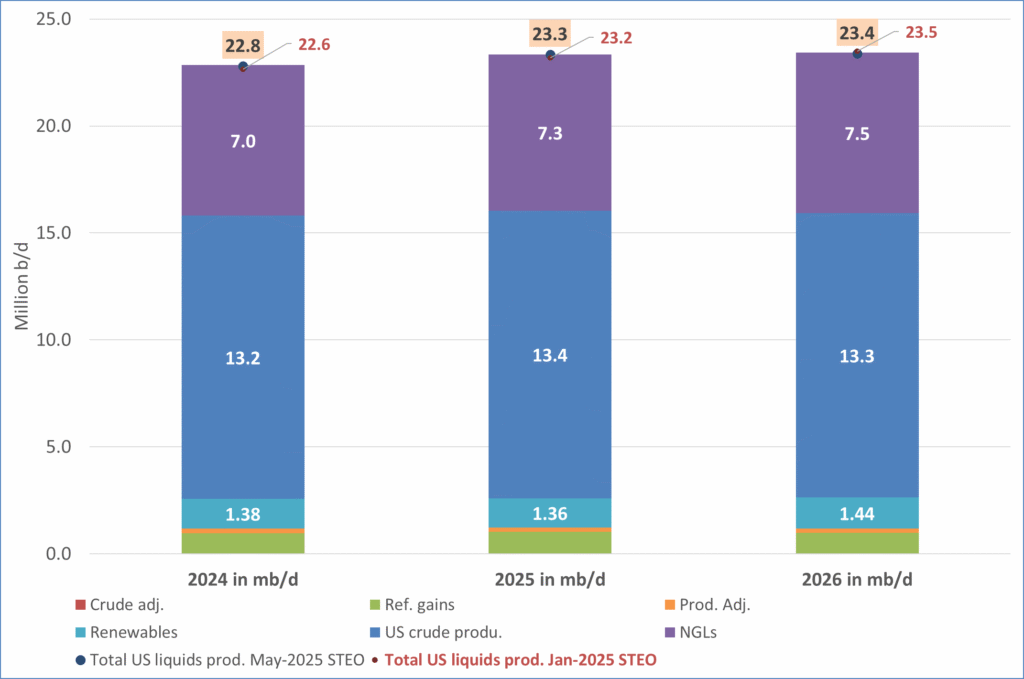
US IEA STEO September report. US crude oil production contracting in 2026, but NGLs still growing. Close to zero net liquids growth in total.
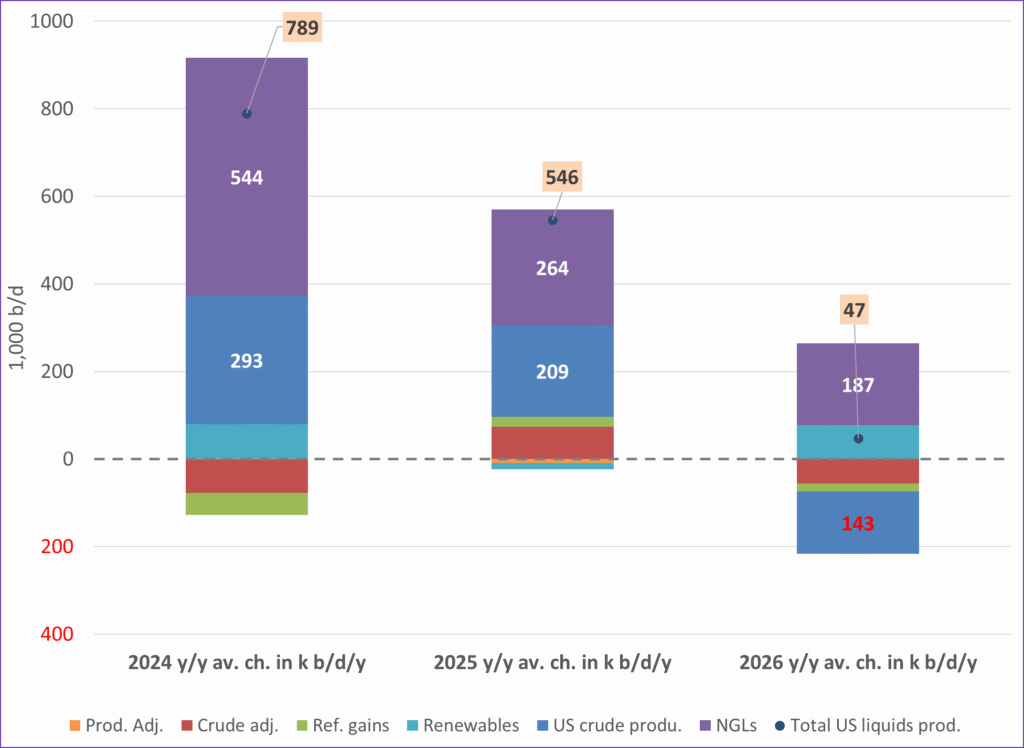
-

 Nyheter4 veckor sedan
Nyheter4 veckor sedanMeta bygger ett AI-datacenter på 5 GW och 2,25 GW gaskraftverk
-
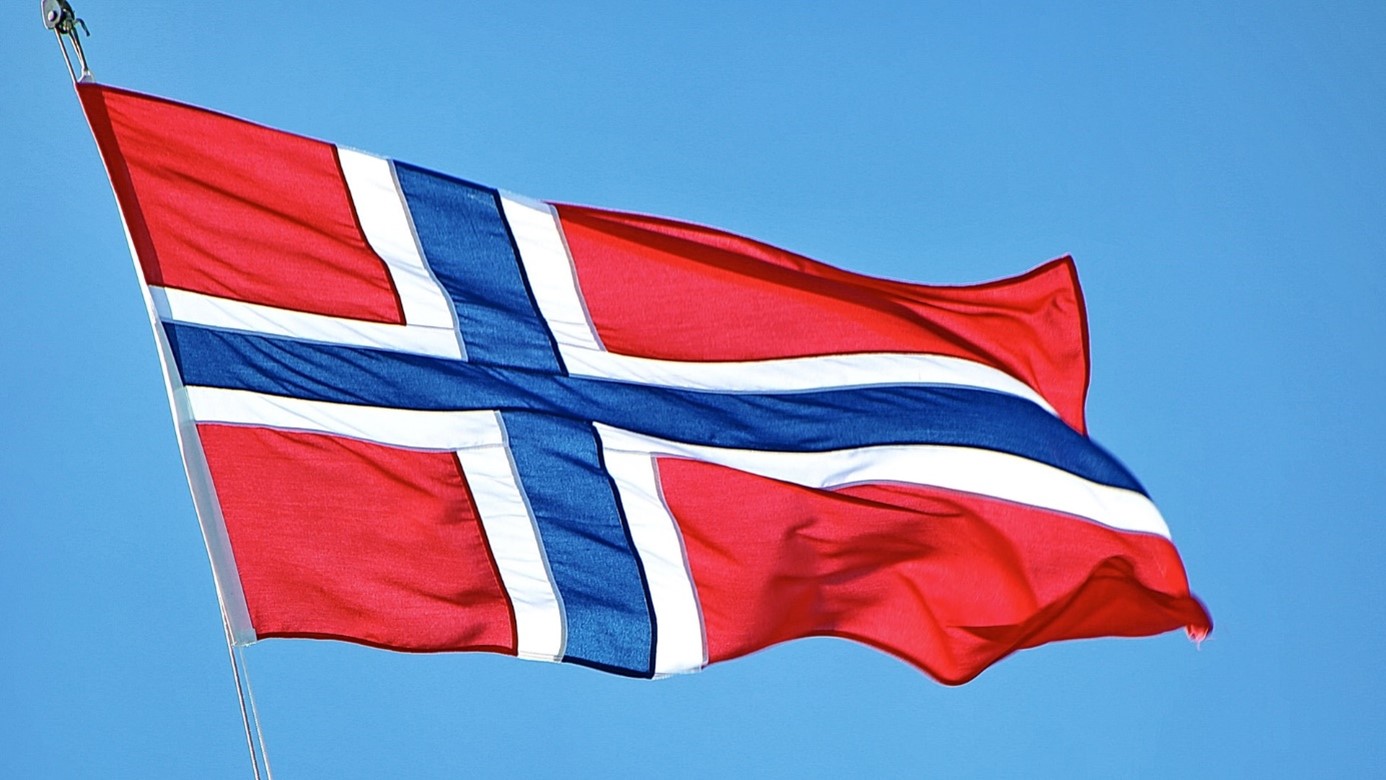
 Nyheter4 veckor sedan
Nyheter4 veckor sedanAker BP gör ett av Norges största oljefynd på ett decennium, stärker resurserna i Yggdrasilområdet
-

 Nyheter4 veckor sedan
Nyheter4 veckor sedanSommarens torka kan ge högre elpriser i höst
-

 Analys4 veckor sedan
Analys4 veckor sedanBrent edges higher as India–Russia oil trade draws U.S. ire and Powell takes the stage at Jackson Hole
-
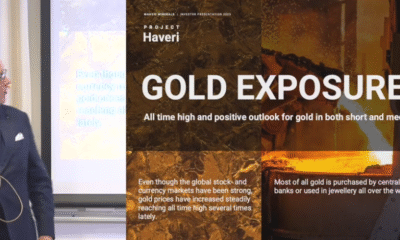
 Nyheter3 veckor sedan
Nyheter3 veckor sedanMahvie Minerals är verksamt i guldrikt område i Finland
-

 Analys3 veckor sedan
Analys3 veckor sedanIncreasing risk that OPEC+ will unwind the last 1.65 mb/d of cuts when they meet on 7 September
-
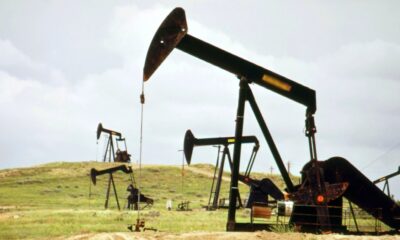
 Nyheter3 veckor sedan
Nyheter3 veckor sedanNeil Atkinson spår att priset på olja kommer att stiga till 70 USD
-

 Analys2 veckor sedan
Analys2 veckor sedanOPEC+ in a process of retaking market share



